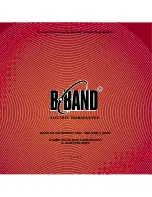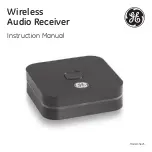
– –
– –
20
21
Acknowledgements and Assured Delivery
When a module transmits with assured delivery enabled, the receiving
module returns an acknowledgement packet. The transmitting module
waits for this acknowledgement for a preset amount of time based on the
data rate. If an acknowledgement is not received, it retransmits the packet.
If the receiver receives more than one of the same packet, it discards
the duplicate packet contents but sends an acknowledgment. This way,
duplicate data is not output by the module.
If the received destination address matches the local address, the
receiving module immediately sends an acknowledgement. This packet
lets the sending module know that the message has been received.
An acknowledgement packet is sent immediately following reception;
CSMA delay is not applied to these packets since permission belongs
to the interacting modules. When the sending module receives the
acknowledgement packet, it marks the current block of data as completed.
If this is the last message in the queue, the sending module takes the BE
line high to indicate that all outgoing data has been sent.
Assured delivery should only be used when addressing a specific module
in a point-to-point link. It should not be used when multiple receivers are
enabled. When address masking is used, only the receiver with an exact
match to the address in the transmitted packet responds. If none of the
enabled receivers has an exact match, then there is no response and the
transmitting module continues to re-transmit the data until the max number
of retries is attempted. This causes the transmitting module to appear slow
or unresponsive. It also impedes valid communications.
Automatic Addressing
The module supports an automatic addressing mode that reads the Source
Address from a valid received packet and uses it to fill the Destination
Address register. This makes sure that a response is sent to the device that
transmitted the original message. This also allows the host microcontroller
to read out the address of the sending unit. The automatic addressing is
enabled for the different addressing modes with register
Address Register Use
Figure 20 shows the address registers that are used with each addressing
mode.
Figure 20: HumPRO-A
TM
Series Transceiver Address Register Use
HumPRO-A
TM
Series Transceiver Address Registers
COMPAT
0x00 (Relaxed Addressing)
0x02 (Normal Addressing)
ADDMODE
0x04
(DSN)
0x06
(User)
0x07
(Ex User)
0x04
(DSN)
0x06
(User)
0x07
(Ex User)
0x14
(DSN
+ACK)
0x16
(User
+ACK)
0x17
(ExUser
+ACK)
0x14
(DSN
+ACK)
0x16
(User
+ACK)
0x17
(ExUser
+ACK)
UDESTID[3-0]
X
X
UDESTID[1-0]
X
X
USRC[3-0]
X
X
X
USRC[1-0]
X
UMASK[3-0]
X
X
X
UMASK[1-0]
X
DESTDSN[3-0]
X
X
Содержание EVM-900-PRO
Страница 1: ...HumPRO ATM Series 900MHz RF Transceiver Module Data Guide...
Страница 60: ...114 115 Notes...














































